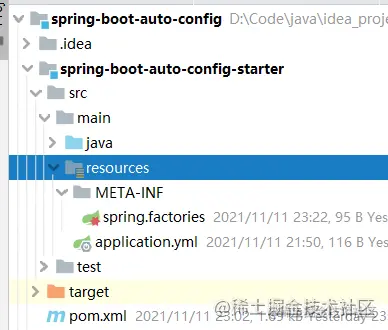SpringBoot实例化Bean
CoderJ 人气:01. 前言
SpringBoot在包扫描时,并不会扫描子模块下的内容,这样就使得我们的子模块中的Bean无法注入到Spring容器中。SpringBoot就为我们提供了spring.factories这个文件,让我们可以轻松的将子模块的Bean注入到我们的Spring容器中,本篇文章我们就一起探究一下spring.factories 跨模块实例化Bean的原理。
我们在SpringBoot项目为何引入大量的starter?如何自定义starter?文章中也讲到构建自己构建starter,其中spring.factories就起到重要的作用,我们是通过spring.factories让starer项目中的Bean注入到Web模块的Spring容器中。本篇文章就来探究一下spring.factories文件,更深层次的东西,以及我们是如何借助该文件实例化Bean的。
2. 配置
spring.factories文件一般都是配置在src/main/resources/META-INF/ 目录下。
也就是说我们在IDEA新建的SpringBoot项目或者Maven项目的资源文件resources目录下新建一个META-INF文件夹,再建一个spring.factories文件即可,新建的文件没有问题的化,一般IDEA都能自动识别,如下图所示。

spring.factories 的文件内容就是接口对应其实现类,实现类可以有多个
文件内容必须是kv形式,即properties类型
org.springframework.boot.autoconfigure.EnableAutoConfiguration=com.zhj.config.AutoConfiguration
如其一个接口有多个实现,如下配置:
org.springframework.boot.logging.LoggingSystemFactory=\ org.springframework.boot.logging.logback.LogbackLoggingSystem.Factory,\ org.springframework.boot.logging.log4j2.Log4J2LoggingSystem.Factory,\ org.springframework.boot.logging.java.JavaLoggingSystem.Factory
3. 原理
在spring -core 中定义了SpringFactoriesLoader 类,这个类就是让spring.factories文件发挥作用的类。SpringFactoriesLoader类的作用就是检索META-INF/spring.factories文件,并获取指定接口将其实现实例化。 在这个类中定义了两个对外的方法:
- loadFactories 根据给定的接口类获取其实现类的实例,这个方法返回的是对象列表
- loadFactoryNames 根据给定的类型加载类路径的全限定类名,这个方法返回的是全限定类名的列表。
源码如下:
public final class SpringFactoriesLoader {
// 文件位置
public static final String FACTORIES_RESOURCE_LOCATION = "META-INF/spring.factories";
// 缓存
private static final Map<ClassLoader, MultiValueMap<String, String>> cache = new ConcurrentReferenceHashMap<>();
private SpringFactoriesLoader() {
}
/**
* 根据给定的类型加载并实例化工厂的实现类
*/
public static <T> List<T> loadFactories(Class<T> factoryType, @Nullable ClassLoader classLoader) {
Assert.notNull(factoryType, "'factoryType' must not be null");
// 获取类加载器
ClassLoader classLoaderToUse = classLoader;
if (classLoaderToUse == null) {
classLoaderToUse = SpringFactoriesLoader.class.getClassLoader();
}
// 加载类的全限定名
List<String> factoryImplementationNames = loadFactoryNames(factoryType, classLoaderToUse);
if (logger.isTraceEnabled()) {
logger.trace("Loaded [" + factoryType.getName() + "] names: " + factoryImplementationNames);
}
List<T> result = new ArrayList<>(factoryImplementationNames.size());
for (String factoryImplementationName : factoryImplementationNames) {
// 实例化Bean,并将Bean放入到List集合中
result.add(instantiateFactory(factoryImplementationName, factoryType, classLoaderToUse));
}
AnnotationAwareOrderComparator.sort(result);
return result;
}
/**
* 根据给定的类型加载类路径的全限定类名
*/
public static List<String> loadFactoryNames(Class<?> factoryType, @Nullable ClassLoader classLoader) {
// 获取工厂类型名称
String factoryTypeName = factoryType.getName();
// 加载所有META-INF/spring.factories中的value
return loadSpringFactories(classLoader).getOrDefault(factoryTypeName, Collections.emptyList());
}
private static Map<String, List<String>> loadSpringFactories(@Nullable ClassLoader classLoader) {
// 根据类加载器从缓存中获取,如果缓存中存在,就直接返回,如果不存在就去加载
MultiValueMap<String, String> result = cache.get(classLoader);
if (result != null) {
return result;
}
try {
// 获取所有jar中classpath路径下的META-INF/spring.factories
Enumeration<URL> urls = (classLoader != null ?
classLoader.getResources(FACTORIES_RESOURCE_LOCATION) :
ClassLoader.getSystemResources(FACTORIES_RESOURCE_LOCATION));
result = new LinkedMultiValueMap<>();
// 遍历所有的META-INF/spring.factories
while (urls.hasMoreElements()) {
URL url = urls.nextElement();
UrlResource resource = new UrlResource(url);
// 将META-INF/spring.factories中的key value加载为Prpperties对象
Properties properties = PropertiesLoaderUtils.loadProperties(resource);
for (Map.Entry<?, ?> entry : properties.entrySet()) {
// key就是接口的类名称
String factoryTypeName = ((String) entry.getKey()).trim();
for (String factoryImplementationName : StringUtils.commaDelimitedListToStringArray((String) entry.getValue())) {
// 以factoryTypeName为key,实现类为value放入map集合中
result.add(factoryTypeName, factoryImplementationName.trim());
}
}
}
// 加入缓存
cache.put(classLoader, result);
return result;
}
catch (IOException ex) {
throw new IllegalArgumentException("Unable to load factories from location [" +
FACTORIES_RESOURCE_LOCATION + "]", ex);
}
}
// 通过反射实例化Bean对象
@SuppressWarnings("unchecked")
private static <T> T instantiateFactory(String factoryImplementationName, Class<T> factoryType, ClassLoader classLoader) {
try {
Class<?> factoryImplementationClass = ClassUtils.forName(factoryImplementationName, classLoader);
if (!factoryType.isAssignableFrom(factoryImplementationClass)) {
throw new IllegalArgumentException(
"Class [" + factoryImplementationName + "] is not assignable to factory type [" + factoryType.getName() + "]");
}
return (T) ReflectionUtils.accessibleConstructor(factoryImplementationClass).newInstance();
}
catch (Throwable ex) {
throw new IllegalArgumentException(
"Unable to instantiate factory class [" + factoryImplementationName + "] for factory type [" + factoryType.getName() + "]",
ex);
}
}
}4. 总结
Spring通过SpringFactoriesLoader实例化Bean的过程
- 获取
SpringFactoriesLoader对应的类加载器 - 查找缓存,查看缓存中是否已经读取到所有jar中classpath路径下的META-INF/spring.factories的内容
- 如果缓存已经存在,根据/spring.factories文件中配置的全限定类名通过反射实例化Bean
- 如果缓存中没有值,则扫描所有jar中的这个META-INF/spring.factories文件,并将其以读取到缓存中,并返回这个配置列表
- 然后根据这个全限定类名的列表再通过反射实例化Bean
加载全部内容